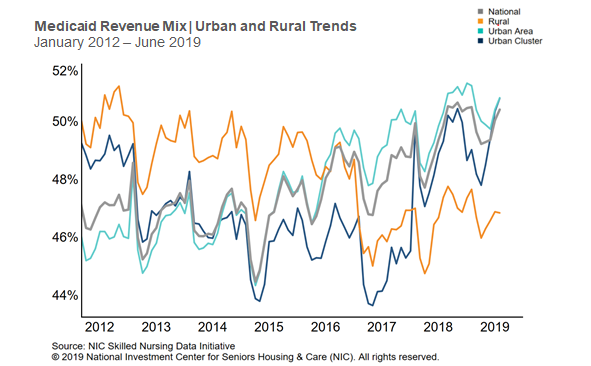1. Occupancy decreased from first quarter, up from year-earlier levels.
2. Medicaid revenue mix over 50%, Managed Medicare revenue mix down from first quarter.
NIC released its second quarter 2019 Skilled Nursing Data Report two weeks ago, which includes key monthly data points from January 2012 through June 2019.
Here are some key takeaways from the report:
- Skilled nursing occupancy decreased 52 basis points to 83.3% in the second quarter of 2019 from the first quarter. However, occupancy was up 48 basis points from year-earlier levels, reflecting the stabilization pattern that has been evident over the past year. Since March 2018, occupancy has fluctuated about one percentage point. A quarterly decline is not unexpected as occupancy usually decreases from March to June due to seasonality. The decrease could be related to flu season coming to an end in the second quarter. The second quarter drop in occupancy was not evident in all geographic areas as occupancy increased slightly in rural areas, while urban areas experienced a decline.

- Quality mix decreased 66 basis points to a near seven-year low of 33.5% in the second quarter and was down 57 basis points from year-earlier levels. Quality mix fell due to declines in both private pay patient day mix and Medicare patient day mix. However, the main driver of the decrease in quality mix has been the decline in Medicare patient day mix, which fell 72 basis points quarter-over-quarter and now stands at a time-series low of 11.5%. Medicare patient day mix has fallen 525 basis points since January 2012. The quality mix trends vary when comparing geographic areas as rural areas saw an increase in the second quarter 2019, while urban areas decreased.
- Medicaid revenue per patient day (RPPD) increased from the first quarter to end the second quarter of 2019 at $215. It was up $6, or 2.7%, compared to a year ago when the RPPD was $209. Medicaid continues to be the fastest growing payor in terms of RPPD on a year-over-year basis, but the concern continues to be that Medicaid RPPD may not cover the cost of care for residents in some states. The growth in Medicaid RPPD is evident in both urban and rural areas as it increased on both a quarterly and yearly basis in both geographies. It ended the second quarter 2019 at $219 in urban areas and $198 in rural areas. Meanwhile, Medicaid revenue mix ended the second quarter 2019 at 50.4% which underscores the importance of following the Medicaid RPPD trend.

- Managed Medicare revenue mix decreased 218 basis points from the first quarter to the second quarter 2019 ending at 10.3%. It was relatively flat from year ago levels. The decrease in overall occupancy along with only a small decrease in managed Medicare patient day mix in the second quarter suggests that the decrease in revenue mix is likely due to RPPD pressure and patient admissions. Managed Medicare RPPD decreased on a quarterly and yearly basis to end the quarter at $432. Managed Medicare RPPD is down $78 since January 2012. The revenue mix trend differed between geographic areas as urban areas drove the overall quarterly trend, declining 231 basis points to end the second quarter 2019 at 12.1%. Rural area revenue mix was flat at 5.2% for managed Medicare.
To get more trends from the latest data you can download the NIC Skilled Nursing Data Report here. There is no charge for this report.
The report provides aggregate data at the national level from a sampling of skilled nursing operators with multiple properties in the United States. NIC continues to grow its database of participating operators in order to provide data at localized levels in the future. Operators who are interested in participating can complete a participation form here. NIC maintains strict confidentiality of all data it receives.
About Bill Kauffman
Senior Principal Bill Kauffman works with the research team in providing research and analysis in various areas including sales transactions and skilled nursing. He has lead roles in creating new and enhanced products and implementation of new processes. Prior to joining NIC he worked at Shelter Development in investing/acquiring, financing, and asset management for over $1 billion in assets. He also had key roles in the value creation and strategic planning and analysis for over 65 entities. He received his Bachelor of Business Administration in Finance from the College of Business and Economics at Radford University and his Master of Science in Finance from Loyola College in Maryland. He also holds the Chartered Financial Analyst Designation (CFA).
Connect with Bill Kauffman
Read More by Bill Kauffman